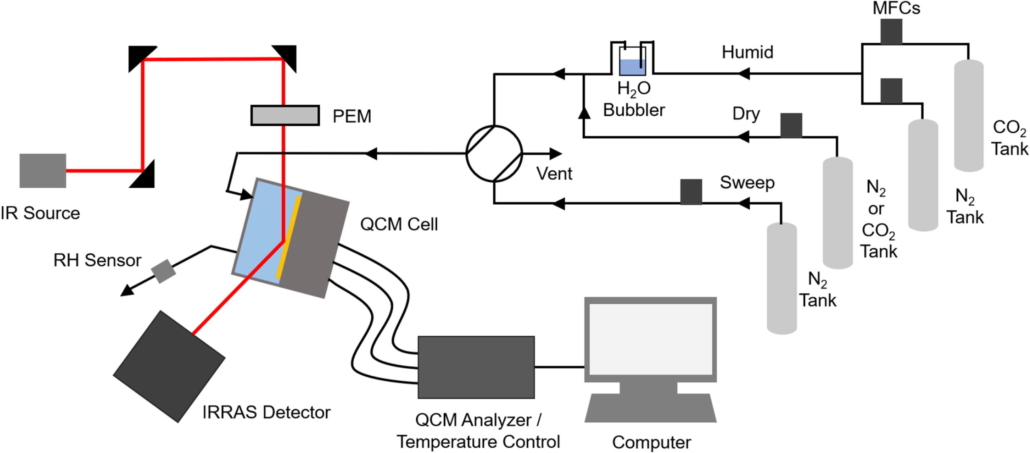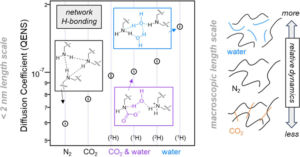The role of humidity in enhancing CO2 capture efficiency in polyethyleneimine thin films
Authors: John R. Hoffman, Avery E. Baumann, Christopher M. Stafford
Journal: Chemical Engineering Journal
 Abstract: Amine impregnated sorbents have been extensively studied for direct air capture (DAC) of CO2 in both dry and humid conditions. In a dry environment, CO2 capture follows a carbamate formation mechanism. Amine efficiency can be improved by allowing more amine sites to participate in the reaction. Introducing water vapor helps break up internal hydrogen bonding within the amine-based polymer, which increases both the polymer mobility and accessibility of amine sites. In this work, we evaluate the influence of humidity on the CO2 capture in polyethyleneimine (PEI) thin films using tandem quartz crystal microbalance (QCM) and polarization modulation infrared reflection–absorption spectroscopy (PM-IRRAS). We show that tandem QCM/PM-IRRAS enables more accurate CO2 uptake measurements, as the combined techniques can separate individual mass changes due to CO2 and H2O sorption. CO2 adsorption capacity and amine efficiency were evaluated for a 10 nm and 100 nm film at varied temperatures, humidities, and CO2 concentrations. We find that water sorption greatly enhances CO2 uptake when the capture is limited by diffusional resistance (at higher CO2 concentration and in 100 nm films) but has less influence in conditions where CO2 availability is limiting uptake (at lower CO2 concentration and in 10 nm films). Thus, we argue that humidity does improve capture, but not at all conditions. Our approach enhances the understanding of H2O-assisted sorption of CO2 in PEI across a range of conditions while also presenting a measurement strategy to apply to, and hopefully optimize, component uptake in materials of interest to the CO2 capture community.
Abstract: Amine impregnated sorbents have been extensively studied for direct air capture (DAC) of CO2 in both dry and humid conditions. In a dry environment, CO2 capture follows a carbamate formation mechanism. Amine efficiency can be improved by allowing more amine sites to participate in the reaction. Introducing water vapor helps break up internal hydrogen bonding within the amine-based polymer, which increases both the polymer mobility and accessibility of amine sites. In this work, we evaluate the influence of humidity on the CO2 capture in polyethyleneimine (PEI) thin films using tandem quartz crystal microbalance (QCM) and polarization modulation infrared reflection–absorption spectroscopy (PM-IRRAS). We show that tandem QCM/PM-IRRAS enables more accurate CO2 uptake measurements, as the combined techniques can separate individual mass changes due to CO2 and H2O sorption. CO2 adsorption capacity and amine efficiency were evaluated for a 10 nm and 100 nm film at varied temperatures, humidities, and CO2 concentrations. We find that water sorption greatly enhances CO2 uptake when the capture is limited by diffusional resistance (at higher CO2 concentration and in 100 nm films) but has less influence in conditions where CO2 availability is limiting uptake (at lower CO2 concentration and in 10 nm films). Thus, we argue that humidity does improve capture, but not at all conditions. Our approach enhances the understanding of H2O-assisted sorption of CO2 in PEI across a range of conditions while also presenting a measurement strategy to apply to, and hopefully optimize, component uptake in materials of interest to the CO2 capture community.



 Aminopolymer sorbents are leading candidates for extracting CO2 directly from the atmosphere under ambient conditions. For effective carbon capture, this requires not only that the CO2 actively binds with amine groups of the polymer under low gas concentrations but also that it readily diffuses through the sorbent media to access as many of the amine binding sites as possible. Unfortunately, high reactivity and diffusivity tend to be mutually exclusive properties when it comes to small molecule transport within a polymer, posing a significant materials design challenge. While many reports to date focus on chemical additives or engineering strategies to tackle this trade-off, only a few studies have seriously investigated the underlying chemical and physical properties of the sorbent polymer as a function of its interaction with the relevant sorbate molecules. In this study, we investigate the interplay of polymer-sorbate reactivity and diffusive dynamics of both H2O and CO2 in branched polyethylenimine (PEI) using quasielastic neutron scattering (QENS), infrared spectroscopy, gravimetric uptake, and mechanical dissipation measurements as a function of atmospheric dosing conditions. We uncover an intriguing and previously unreported discrepancy in the diffusive dynamics of PEI dosed with CO2 and H2O vapor at the microscopic and macroscopic length scales. At the macroscopic scale, our mechanical dissipation measurements show that while the exposure to H2O vapor alone always plasticizes the dynamics of PEI, the absorption of CO2, either in the presence of H2O or not, leads to a mechanical stiffening of the PEI. Interestingly, this response differs at the microscopic scale where the diffusive dynamics of the H2O- and/or CO2-dosed samples as quantified by QENS are always enhanced relative to the undosed PEI. This dynamic facilitation is greatest in the presence of H2O vapor alone, consistent with H2O strongly plasticizing the dynamics of PEI. However, the simultaneous exposure to both H2O and CO2 leads to a stiffening of the QENS dynamics at the microscopic scale relative to the hydrated state, signifying local interactions between the CO2 and the polymer. Under these conditions, we also observe a greater amount of CO2 absorbed into the PEI film that is simultaneously exposed to both H2O and CO2 as compared to the film exposed to just CO2, further evidencing a complicated three-way interaction between the H2O, CO2, and PEI. These results are discussed in terms of an absorption process that involves the formation of carbamate ions, the generation of ionic cross-link junctions in the PEI, and changes in the local hydration level of the polymer around the ions. To establish the importance of the carbamate ions in this process, we utilize a methylation reaction to modify the PEI and convert all of the primary and secondary amines into tertiary amines that are incapable of forming carbamates. This considerably diminishes the role of hydrogen bonding in the PEI, enhances the microscopic dynamics of the undosed PEI, and results in diffusive dynamics that do not depend heavily on dosing with H2O and/or CO2. The observations reported here provide insights into the design of next-generation aminopolymer sorbents where both reactivity and diffusive dynamics can be optimized.
Aminopolymer sorbents are leading candidates for extracting CO2 directly from the atmosphere under ambient conditions. For effective carbon capture, this requires not only that the CO2 actively binds with amine groups of the polymer under low gas concentrations but also that it readily diffuses through the sorbent media to access as many of the amine binding sites as possible. Unfortunately, high reactivity and diffusivity tend to be mutually exclusive properties when it comes to small molecule transport within a polymer, posing a significant materials design challenge. While many reports to date focus on chemical additives or engineering strategies to tackle this trade-off, only a few studies have seriously investigated the underlying chemical and physical properties of the sorbent polymer as a function of its interaction with the relevant sorbate molecules. In this study, we investigate the interplay of polymer-sorbate reactivity and diffusive dynamics of both H2O and CO2 in branched polyethylenimine (PEI) using quasielastic neutron scattering (QENS), infrared spectroscopy, gravimetric uptake, and mechanical dissipation measurements as a function of atmospheric dosing conditions. We uncover an intriguing and previously unreported discrepancy in the diffusive dynamics of PEI dosed with CO2 and H2O vapor at the microscopic and macroscopic length scales. At the macroscopic scale, our mechanical dissipation measurements show that while the exposure to H2O vapor alone always plasticizes the dynamics of PEI, the absorption of CO2, either in the presence of H2O or not, leads to a mechanical stiffening of the PEI. Interestingly, this response differs at the microscopic scale where the diffusive dynamics of the H2O- and/or CO2-dosed samples as quantified by QENS are always enhanced relative to the undosed PEI. This dynamic facilitation is greatest in the presence of H2O vapor alone, consistent with H2O strongly plasticizing the dynamics of PEI. However, the simultaneous exposure to both H2O and CO2 leads to a stiffening of the QENS dynamics at the microscopic scale relative to the hydrated state, signifying local interactions between the CO2 and the polymer. Under these conditions, we also observe a greater amount of CO2 absorbed into the PEI film that is simultaneously exposed to both H2O and CO2 as compared to the film exposed to just CO2, further evidencing a complicated three-way interaction between the H2O, CO2, and PEI. These results are discussed in terms of an absorption process that involves the formation of carbamate ions, the generation of ionic cross-link junctions in the PEI, and changes in the local hydration level of the polymer around the ions. To establish the importance of the carbamate ions in this process, we utilize a methylation reaction to modify the PEI and convert all of the primary and secondary amines into tertiary amines that are incapable of forming carbamates. This considerably diminishes the role of hydrogen bonding in the PEI, enhances the microscopic dynamics of the undosed PEI, and results in diffusive dynamics that do not depend heavily on dosing with H2O and/or CO2. The observations reported here provide insights into the design of next-generation aminopolymer sorbents where both reactivity and diffusive dynamics can be optimized.

